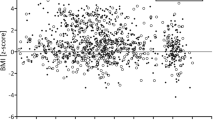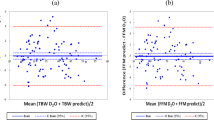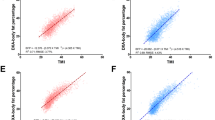Abstract
OBJECTIVE: The objective of the study was to test the hypothesis that differences in the relationship between percent body fat (%BF) and body mass index (BMI) between populations can be explained (in part) by differences in body build.
DESIGN: Cross-sectional, comparative study.
SUBJECTS: 120 age, gender and BMI matched Singapore Chinese, Beijing Chinese and Dutch (Wageningen) Caucasians.
MEASUREMENTS: From body weight and body height, BMI was calculated. Relative sitting height (sitting height/height) was used as a measure of relative leg length. Body fat was determined using densitometry (underwater weighing) in Beijing and Wageningen and using a three-compartment model based on densitometry and hydrometry in Singapore. Wrist and knee widths were measured as indicators for frame size and skeletal mass was calculated based on height, wrist and knee width. In addition, a slenderness index (height/sum of wrist and knee width) was calculated.
RESULTS: For the same BMI, Singapore Chinese had the highest %BF followed by Beijing Chinese and the Dutch Caucasians. Singaporean Chinese had a more slender frame than Beijing Chinese and Dutch Caucasians. Predicted %BF from BMI, using a Caucasian prediction formula, was not different from measured %BF in Wageningen and in Beijing, but in Singapore the formula underpredicted %BF by 4.0±0.8% (mean±s.e.m.) compared to Wageningen. The difference between measured and predicted %BF (bias) was related to the level of %BF and with measures of body build, especially slenderness. Correction for differences in %BF, slenderness and relative sitting height, decreased the differences between measured and predicted values compared to the Dutch group from 1.4±0.8 (not statistically significant, NS) to −0.2±0.5 (NS) in Beijing and from 4.0±0.8 (P<0.05) to 0.3±0.5 (NS) in Singapore (all values mean±s.e.m.).
CONCLUSIONS: The study results confirm the hypothesis that differences in body build are at least partly responsible for a different relationship between BMI and %BF among different (ethnic) groups.
This is a preview of subscription content, access via your institution
Access options
Subscribe to this journal
Receive 12 print issues and online access
$259.00 per year
only $21.58 per issue
Buy this article
- Purchase on Springer Link
- Instant access to full article PDF
Prices may be subject to local taxes which are calculated during checkout
Similar content being viewed by others
Author information
Authors and Affiliations
Corresponding author
Rights and permissions
About this article
Cite this article
Deurenberg, P., Deurenberg Yap, M., Wang, J. et al. The impact of body build on the relationship between body mass index and percent body fat. Int J Obes 23, 537–542 (1999). https://doi.org/10.1038/sj.ijo.0800868
Received:
Revised:
Accepted:
Published:
Issue Date:
DOI: https://doi.org/10.1038/sj.ijo.0800868
Keywords
This article is cited by
-
Myosteatosis: a potential missing link between hypertension and metabolic disorder in the Asian population
Hypertension Research (2023)
-
Infant Body Composition in an Asian Pacific Islander Population
Journal of Racial and Ethnic Health Disparities (2023)
-
Twelve-Year Trajectory of Disease Burden and Mortality by Obesity Level in Korea: Analysis of the National Health Insurance Service Database
Obesity Surgery (2023)
-
Relationship between BMI with percentage body fat and obesity in Singaporean adults – The Yishun Study
BMC Public Health (2021)
-
Ethnic Specific body fat percent prediction equation as surrogate marker of obesity in Ethiopian adults
Journal of Health, Population and Nutrition (2021)



